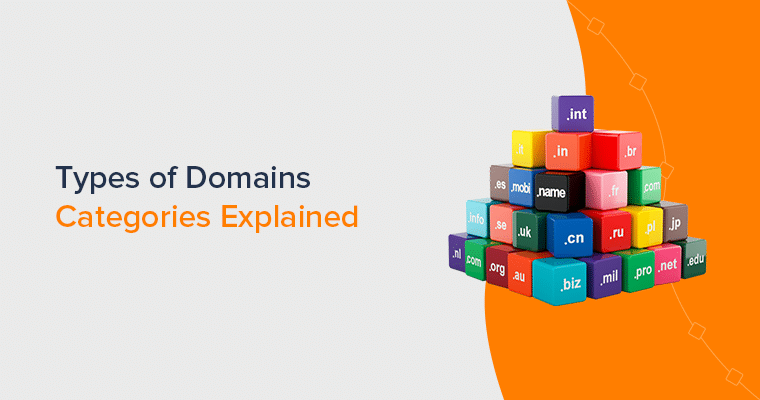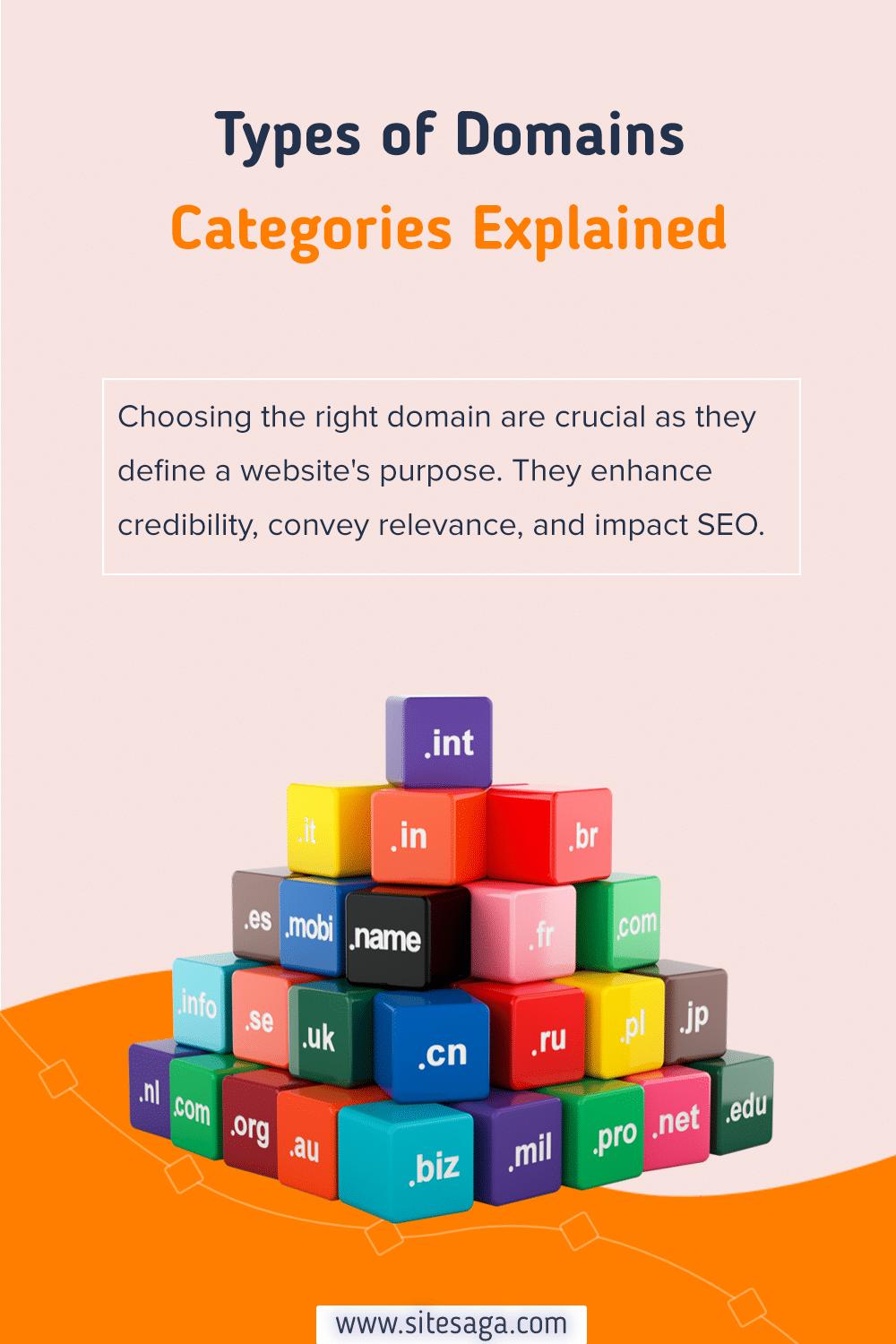Want to learn about the different types of domains besides .com or .net? Or considering getting unique domains for your website? If yes, then you’ve come to the right place!
A domain is a web address that people use to find websites on the internet. It’s crucial for an online presence, serving as a unique web address. It helps people access, remember, and trust your website.
As more businesses decide to go digital, there’s a growing competition for good domain names.
So, in this article, we’ll break down the different types of domains. Helping you choose the best one for your website.
Table of Contents
What are Domains?
Alright, let’s start by understanding what a website domain name is.
Essentially, a domain name is that part you see between the protocol sign (HTTP://) and the first slash in a URL or web address. It’s the unique tag that helps identify and locate a particular place on the internet.
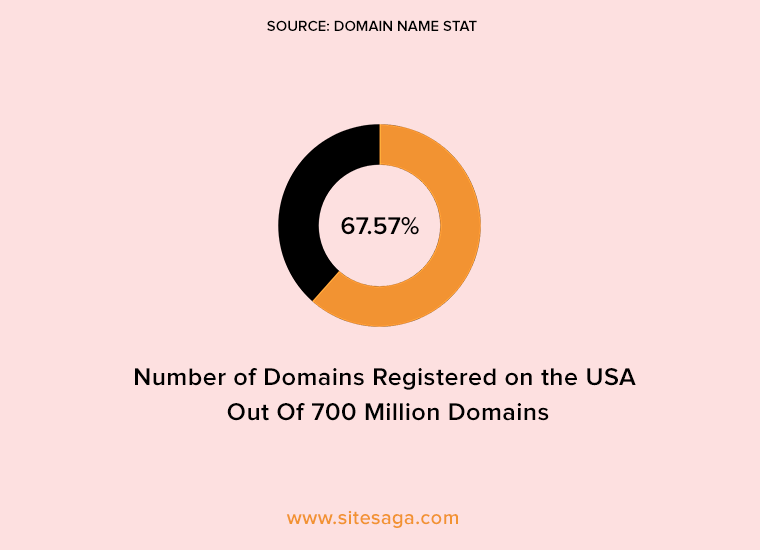
Source: Domain Name Stat
For the record,
- There are around 700 million active domain names. (Source)
- 61.57% are registered in the United States of America. (Source)
For example, for our website “https://www.sitesaga.com” the domain name is sitesaga.com.

But there’s more to it! That name is like a shortcut for the computer or website’s actual address, known as the IP address.
And, all devices connected to the internet get assigned a special code known as an IP address. This code is like a unique tag given to a device, and it can’t be shared with another device at the same time.
Want detailed information on what a domain name is? Do check our complete guide on what is domain name and how it works.
What are Domains Used For?
Domains play a crucial role in the online world, serving as the addresses for websites. Essentially, they are like the street names that guide you to a particular destination on the internet.
These unique names are used for several important purposes:
- Website identification: Domains make it easy for users to locate and remember specific online destinations.
- Branding: A well-chosen domain reflects the identity of the website or business and contributes to brand recognition.
- Navigation: Instead of memorizing complex numerical IP addresses, users can type in a user-friendly domain to access a website.
- Email: Domains form part of the email domain, helping direct messages to the correct mail server.
- Online Presence: For individuals, organizations, or businesses, having a domain is essential for establishing a credible online presence.
In summary, domains are the virtual addresses that make the internet user-friendly. Enabling effective identification, branding, and navigation in the online space.
Quick Overview of Domain Name System (DNS)
Domain Name System (DNS) operates by taking the name of a website and translating it into a special set of numbers known as an IP address. This translation process happens thanks to servers called Domain Name System servers.
These servers are spread out across the globe in vast numbers, yet they function as a unified and cohesive database. Ensuring that whenever you type in a web address, you’re connected to the right place on the internet.

However, not mentioning the specific type of domain extension for your website means it goes through a sorting process on a server. This process follows the hierarchy of the Domain Name System.
Initially, starting from top-level extensions and moving down the line. This organized approach has significantly improved the ease of navigating the World Wide Web. Encouraging a growing number of people to make use of its services.
Some of the best premium DNS hosting providers include Namecheap, WordPress.com, Cloudflare, and DNS Made Easy.
Different Types of Domains
Now let’s take a look at different types of domains.
Top-level Domains (TLDs)
Top-level domains (TLDs) are the highest level in the Domain Name System (DNS) hierarchy. These are the endings you see at the end of a web address, like .com, .org, or .net. TLDs play a crucial role in organizing and categorizing websites on the internet.
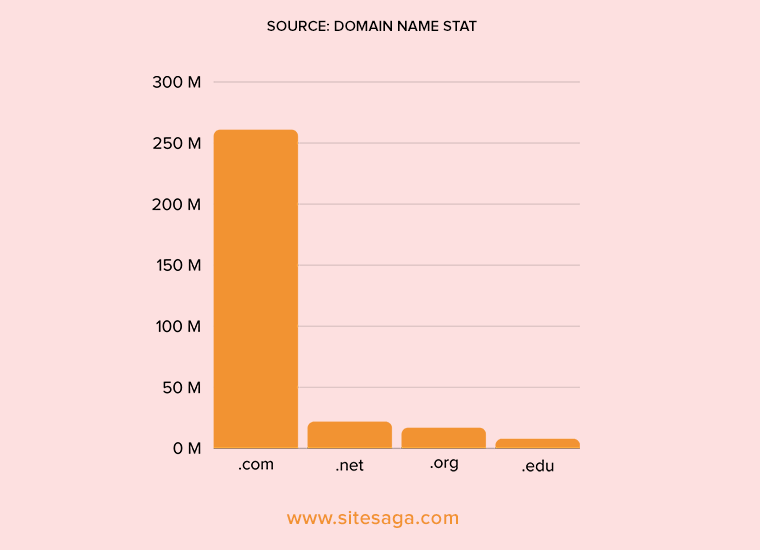
Source: Domain Name Stat
Let’s go down to know some of the popular top-level domains.
1. .com
This domain stands for commercial and was the first widely used top-level domain. Originally designed for commercial organizations, .com became hugely popular for businesses, websites, and email.
Despite its initial commercial focus, the restrictions on .com were not strictly enforced. For instance, the popular website Forbes uses the .com domain “https://www.forbes.com/.”
As per the record, there are 261 million .com registered domains. (Source)
2. .net
It’s short for network and was specifically created for websites involved in network technologies. For example, ThemeForest.net is a popular website with a library of premium WordPress themes to buy for your website.
Similar to .com, .net’s intended use for networking was not strictly followed. Making it a widely used alternative, often considered as the second-best to .com.
And until now, there are more than 22 million .net domains registered. (Source)
3. .edu
There are over 8,000 websites registered under the .edu domain. This domain represents education and was intended for educational institutions globally.
However, over time, it became associated mainly with American educational centers. Also, schools from other countries often combine .edu with their country-level domain.
To take an example, the Stanford University website uses stanford.edu.
Besides, having a .edu domain can enhance online presence. Also, provides a clear identifier for individuals seeking reliable educational resources.
4. .org
Shorthand for organizations, was initially intended for nonprofits. Despite its original purpose, .org is now used by nonprofits, for-profit businesses, schools, and communities.
Besides, .org makes the sites look trustworthy and reliable. So, it’s not just for nonprofits. And, you don’t need to meet strict rules like some other domains. This makes .org a popular choice for all kinds of businesses.
Some of the examples are WordPress.org and Wikipedia.org.
Additionally, there are over 17 million registered .org domains. (Source)
5. .gov
The .gov top-level domain is a special web address used by government official websites. It’s like the ending part of a website name, like www.cdc.gov. So, you can say .gov is only for official government websites and people who work for the government.
When you see a website with .gov, it means the information there is from the government. People trust .gov sites because they know it’s official and important.
6. .mil
This domain extension is specifically reserved for use by the United States military. Displaying official and secure online platforms associated with the U.S. Department of Defense.
Examples of websites utilizing the .mil extension include branches of the military such as the Army.mil, af.mil, Marines.mil, etc.
This domain helps people trust that the info on these sites is really from the U.S. military and follows strict security rules.
Besides these, there are other top-level domains like .info, .biz, .pro, etc.
Country Code Top-level Domains (ccTLD)
A country code top-level domain (ccTLD) is like an address on the internet that is usually connected to a specific country or place. These addresses are short, usually just two letters, and are meant to show which country they belong to.
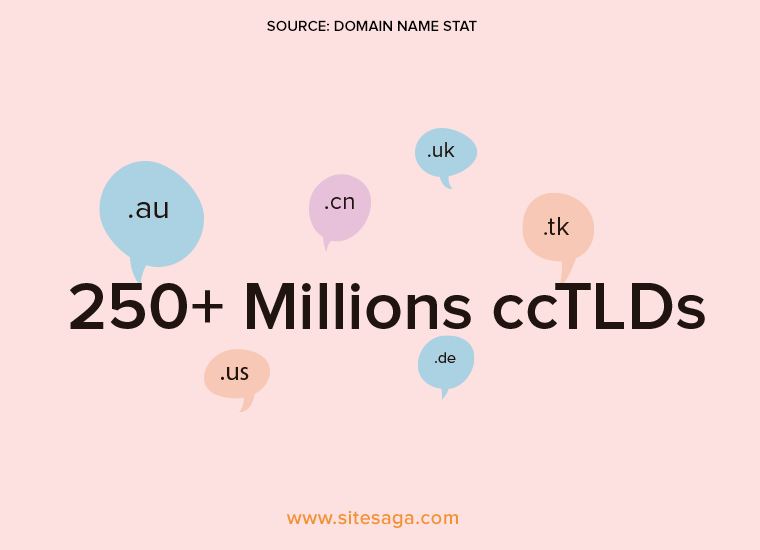
Source: Domain Name Stat
Unlike other types of internet addresses, like those ending in .com or .org, which have to follow international rules. ccTLDs have their own rules set by each country’s organization in charge of domain names.
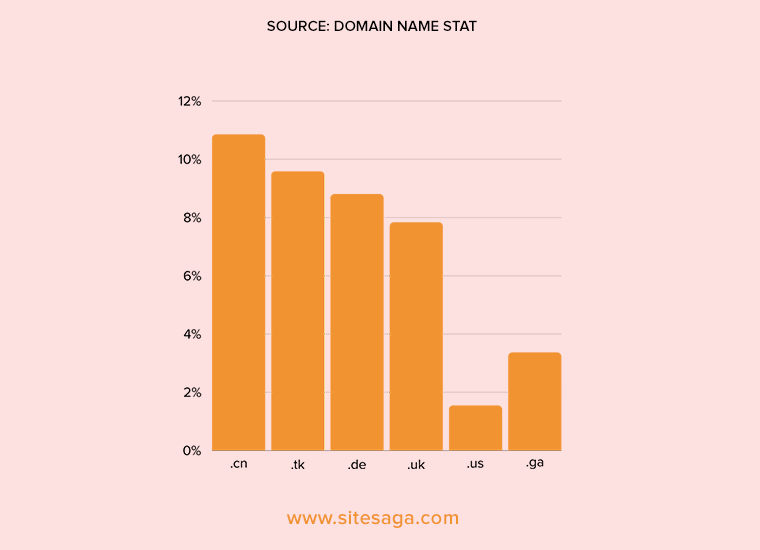
Source: Domain Name Stat
As per the record,
- There are more than 250 million of these country-specific domain registrations. (Source)
- While .cn (China) has 10.86%. (Source)
- And the .tk (Tokelau) has 9.59%. (Source)
- While .de (Germany) holds 8.81% of total ccTLDs. (Source)
- At the same time, .uk (United Kingdom) has 7.84% of its share. (Source)
- Whereas, .us (United States of America) occupies 1.55%. (Source)
- Likewise, .ga (Gabon) holds 3.37%. (Source)
Let’s take a quick peek at some of the country code top-level domains.
- .cn: The .cn domain plays a crucial role in establishing a distinct online presence for Chinese individuals, organizations, and businesses like Tencent.cn.
- .tk: Associated with Tokelau, has gained global attention as it’s freely available for registration by anyone around the world. For example, Kiekko.tk.
- .de: It serves as the online identifier for websites, businesses, and entities based in Germany or those closely affiliated with the country. For instance, Studyflix.de.
- .uk: It serves as a unique identifier for websites, businesses, and organizations based in the United Kingdom, for example, www.gov.uk.
- .us: Associated with the United States, this domain is generally open to individuals, businesses, and entities both inside and outside of the United States like Teslastore.us.
- .ga: Associated with Gabon, a country located in Central Africa, and is commonly used by individuals, businesses, and organizations like Birria.ga.
All these domains are managed by designated authorities within each country or territory, and the rules and regulations for registering ccTLDs can vary.
So, you get the idea of ccTLDs here, right?
In the end, it plays a crucial role in defining the online identity of a website based on its geographical location or affiliation.
Generic Top-level Domains (gTLDs)
Generic top-level domains or gTLDs are special categories under Top-level Domains. And the main ones are at the very top level of the whole internet address system.
Namely,
- .com
- .net
- .org
- .biz
- .info
It’s called the root zone, and it’s like the highest level in the structure of how domain names work.
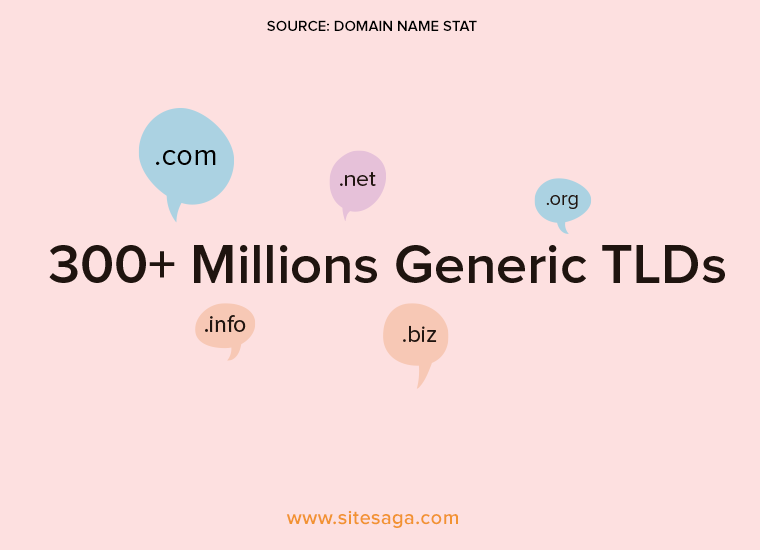
Source: Domain Name Stat
Even though more than 300 million different gTLDs are registered, these are the most common. Also covers the majority of all the different types of web addresses you see.
They play a big role in organizing and categorizing websites. Making it easier for people to find what they’re looking for online.
Let’s take a quick look at some of the types of gTLDS!
1. Generic Restricted
Generic Restricted Top-Level Domains (gTLDs) are a special category of domain extensions. Unlike standard gTLDs, they have certain limitations on who can register them. These restrictions are often defined by the registry or managing authority.
The eligibility criteria may be based on factors like industry affiliation, geographic location, or adherence to specific guidelines. Examples of generic restricted TLDs include .biz for businesses or .pro for credentialed professionals and related entities.
Until now, there are over 3 million registered .biz domains and over 900,000 registered under .pro domain.
2. Sponsored
A sponsored gTLD is like a special club on the internet where a specific community has its unique web address ending. This community could be based on things like ethnicity, location, profession, or specific themes suggested by private groups.
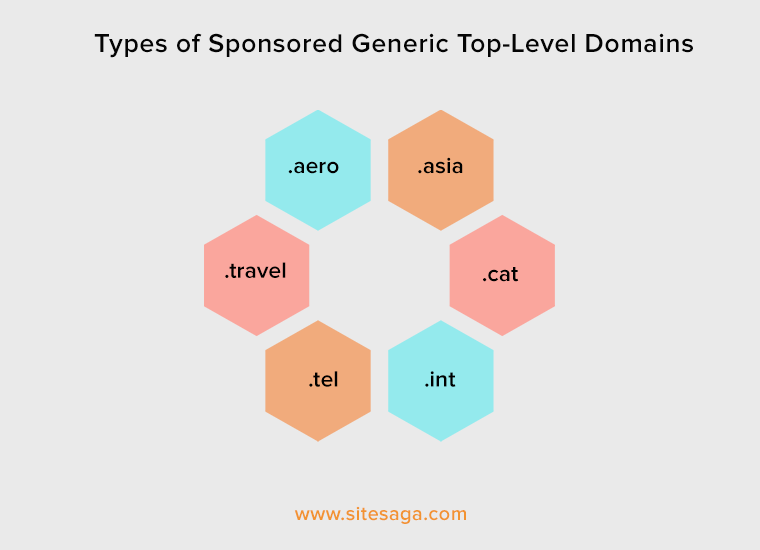
For example, “.aero” is a special web address sponsored by SITA. Only people in the air transport industry can use it. It adds a bit of order and makes sure that the web address fits the community it represents.
Some other examples are, .asia, .jobs, .travel, .tel, etc.
3. Infrastructure
.arpa is the unique and specialized infrastructure of gTLDs. Unlike common TLDs, .arpa serves a distinct purpose and is not intended for regular website registrations.
Instead, it’s used for infrastructure-related functions, specifically in the context of the Address and Routing Parameter Area (ARPA) domain.
Also, there are subdomains of ARPA which are maintained by the Internet Assigned Numbers Authority (IAAN). As per the record, there are 7,158 registered domains under .arpa.
Let’s take a look at some of them!
| Domain | Purpose |
|---|---|
| home.arpa | Residential networking. |
| iris.arpa | Locating internet registry information service. |
| ns.arpa | For hosting authoritative DNS servers for the .arpa domain. |
| resolver.arpa | For the discovery of designated DNS resolvers |
New gTLDs
Introduced as part of the expansion, New gTLDs provide a wide array of extensions beyond the traditional domains. Furthermore, these extensions range from industry-specific terms to creative and brand-focused options.
New gTLDs allow website owners to tailor their domain extensions to better reflect their brand. As a result, website owners can choose from a diverse range of new gTLDs such as .app for applications, .blog for blogs and content creators, and more.
As per the record,
- .blog has over 500,000 registered domains. (Source)
- And .app holds over 1 million registered domains. (Source)
- Similarly, .life has over 800,000 registered domains. (Source)
Let’s take a look at some widely used types of New gTLDs:
1. Generic or Standard
These are open for registration by the general public without specific restrictions. They cover a wide range of generic terms and are often used for various purposes.
For example, Rideguru helps you estimate and compare fares and uses .guru in the URL as “ride.guru.” Also, the .guru domain has over 100,000 registrations.
Other examples are, .online, .space, .website, .store, .shop, .tech, .company, etc.
2. Community
These gTLDs are designed for specific communities with shared interests, values, or characteristics. While registration is often restricted to members of the community.
For example, weconnect.lgbt is an LGBT community and media brand that uses the .lgbt domain. While The Old Catholic Church uses the “.church” domain, which looks like “theoldcatholic.church.”
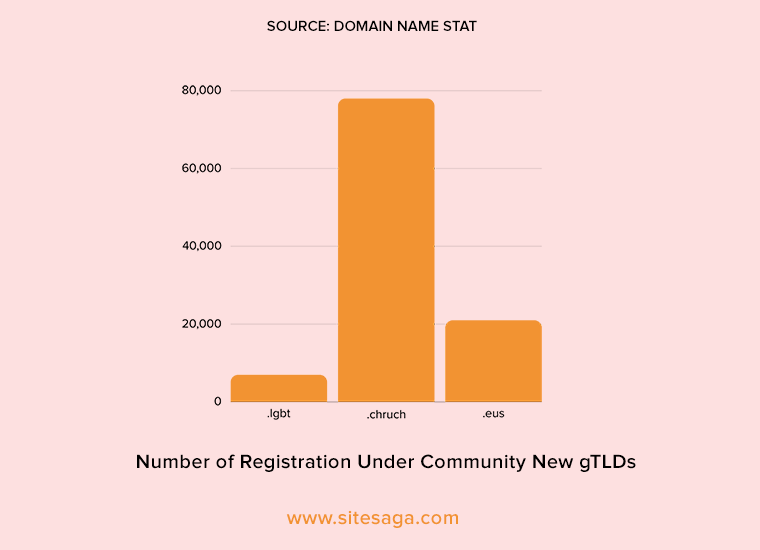
Source: Domain Name Stat
Let’s see the number of registrations under the community New gTLDs:
- The .lgbt had over 7,000 registered domains until now. (Source)
- While .church has over 48,000 domains registered. (Source)
- Likewise, .eus representing the Basque community holds over 21,000 registered domains. (Source)
Some other examples of community domains are .art, .med, .yoga, .music, .eco, .film, .radio, .sport, etc.
3. Geographic TLDs
Geographic TLDs represent specific cities, regions, or countries. They often require support from the local government and aim to create a localized online presence.
For example, Wyeth offers unique furniture under the URL wyeth.nyc using the domain .nyc (New York.) Also, this domain holds 105,503 registrations.
Likewise, there are some other domains under Geographic TLDs, they are .berlin, .london, .tokyo, .vegas, .paris, .quebec, .bcn, etc.
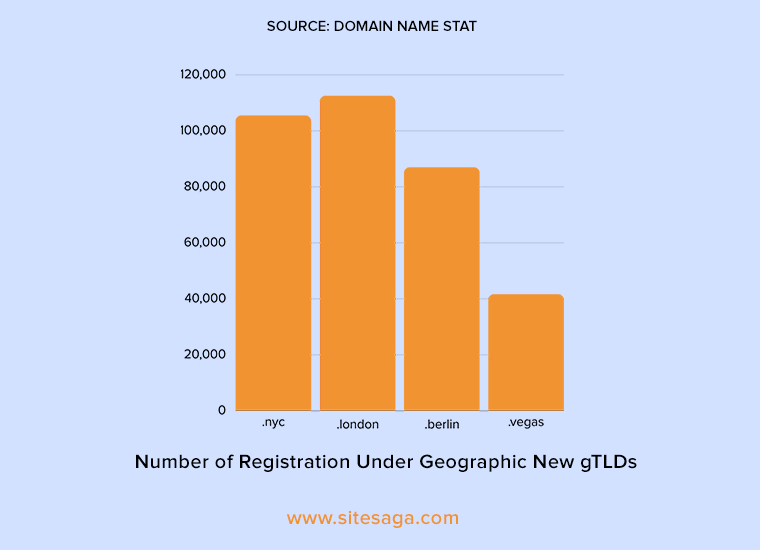
Source: Domain Name Stat
Most of them are popular as per the record,
- The .london has 112,539 domain registrations. (Source)
- While .berlin has 87,013 registered domains. (Source)
- Whereas, .vegas holds 41,679 registered domains. (Source)
4. Brand
Brand TLDs are directly related to trademarked brands, allowing companies to strengthen their online brand identity. Moreover, registration is typically limited to the brand owner.
For example, Google has a dedicated domain about.google for their about page using the .google extension.
Likewise, .nexus is another example of brand New gTLDs and holds over 1,000 registered domains. (Source)
5. Restricted
These TLDs have specific eligibility criteria for registration, limiting access to certain requirements. Restrictions can be based on industry, membership, or other factors.
For example, the Main State Bar uses mainebar.community.lawyer with .lawyer as the brand domain.
Other examples are .bank, .pharmacy, .tennis, .law, .doctor, .uni, .hotel, .auto, .insurance, .lawyer, etc.
6. Open TLDs
Open TLDs are accessible to the general public without restrictions. They provide a flexible space for diverse registrations. For example, RSS, a popular web application uses the .app domain as rss.app.
Some other examples of open TLDs are, .online, .space, .website, .blog, .shop, .app, .cloud, .market, .guru, .store, etc.
Second-level Domains
A second-level domain (SLD or 2LD) is part of a domain name that is located directly left of the top-level domain. In a domain like “sitesaga.com,” “sitesaga” is the second-level domain.

The second-level domain is where organizations have the most flexibility to create a unique and memorable identifier. It’s often chosen to reflect the brand, purpose, or content of the website.
For instance, in “www.apple.com,” “apple” is the second-level domain and is associated with the Apple brand.
Choosing a meaningful and relevant second-level domain is important for recognition and user recall. Also, it’s a significant part of the web address that users interact with and remember.
Purpose of Second-level Domain
Now let’s look into the purpose of a second-level domain in a URL. We’ll take sitesaga.com as an example URL to break down the purpose.
- Branding: The second-level domain, “sitesaga,” serves as the primary brand identifier. It’s concise, relevant, and reflects the business’s focus on web technology.
- Memorability: Visitors can easily remember the website’s name due to the straightforward and descriptive second-level domain. This aids in word-of-mouth referrals and repeat visits.
- Niche Focus: The choice of the word “site” in the second-level domain communicates the niche web technology. This helps attract a specific target audience interested in such products.
- Search Engine Optimization (SEO): The second-level domain can contribute to the website’s visibility on search engines. When users search with the word “website,” having the relevant keywords in the domain can positively impact search rankings.
- Professionalism: A well-chosen second-level domain adds a professional touch to the online presence. Also, this builds confidence in visitors that they are dealing with a legitimate source.
Third-level Domains
Third-level domains come before the second-level domain in the hierarchical structure of domain names. They are created by adding a label to the left of the second-level domain, separated by a dot. For example, in the domain “blog.example.com,” “blog” is the third-level domain.
Third-level domains are often used within a larger domain for organizational or navigational purposes. Organizations might utilize third-level domains to create distinct sections for various departments, products, or services.

For example, “mail.google.com” is a subdomain within Google specifically designated for email services. Users visiting this address access Google’s email platform directly without additional navigation.
Purpose of Third-level Domain
Now, let’s look into the purpose of using the third-level domain in your domain name.
- Content organization: By creating subdomains, such as “blog.example.com” or “shop.example.com,” they can maintain a clear and logical structure.
- Functional segmentation: It helps to separate different functions or services. For instance, “support.example.com” can be dedicated to customer support, while “events.example.com” focuses on upcoming events.
- Improved user experience: Visitors can intuitively navigate through the website, understanding the purpose of each subdomain without unnecessary complexity.
- Independent branding: Subdomains can have unique designs, themes, and branding elements while still being associated with the brand theme.
- Scalability and flexibility: As content or services expand, new subdomains can be created without altering the main structure. Providing a flexible solution for future growth and changes in website functionality.
- Targeted marketing: You can create “sale.example.com” for promotional events. This directs users interested in the discounts or special offers section of the website.
Note: Please note that this is not an exhaustive list, and many more domains exist. Additionally, new domains are periodically introduced, so the list may evolve.
Also, check our article to find out some of the best domain name registrars available. Some of them are Namecheap, GoDaddy, NameSilo, and Register.com.
Tips for Choosing the Right Domains
Choosing the right domain is a crucial step in establishing your online presence. Here are some tips to help you make an informed decision:
| Tips | Description |
|---|---|
| Relevance and Memorability | Opt for a domain that is relevant to your content, business, or purpose. It should be easy to remember, spell, and pronounce. Avoid complex or long names that might confuse visitors. |
| Choose a Recognizable TLD | Consider using well-known top-level domains (TLDs) like .com, .net, or .org. Users commonly trust these and are easier to remember. |
| Include Keywords | If relevant, include keywords that reflect your business or website content in the domain. This improves SEO and helps users understand your site’s focus. |
| Consider Localization | If your business targets a specific geographic location, consider using country code top-level domains (ccTLDs). Or include location-specific keywords in your domain. |
| Think Long-Term | Choose a domain that will grow with your business. Avoid trends or overly specific names that might become obsolete as your business evolves. |
| Check Domain Availability | Before finalizing your choice, ensure that the domain is available. Use domain registration platforms to check the availability of your desired domain. |
| Protect Your Brand | Consider registering variations of your domain to prevent others from using similar names that could confuse your audience. This includes common misspellings or different TLDs. |
| Evaluate Social Media Availability | Check the availability of your desired domain name on social media platforms. Consistent branding across your website and social media enhances your online presence. |
By considering these tips, you can choose a domain that not only represents your brand effectively. It also contributes to a positive user experience and online visibility.
Now, let’s head towards answering some of your common questions.
Frequently Asked Questions
1. What is the difference between New gTLDs and gTLDS?
The main difference lies in the timeline of their introduction. New gTLDs represent a wave of domain extensions introduced after 2013, such as .app, .blog, and .guru. Whereas, gTLDs, is a broader category that includes both traditional extensions and newer ones.
2. Are domain extensions free?
Domain extensions are not typically free. While there are some exceptions and special promotions that may offer free or discounted domain registrations for a limited time.
3. Can you register domains in a different country?
Yes, it’s possible to register domains in a different country. Many ccTLDs have specific registration requirements with residence within or affiliated with that country. However, some countries have opened up registration to entities outside their borders.
4. Is it possible to change domain names?
While it is technically possible, it’s not a straightforward process and may have implications for your website’s SEO, branding, and existing links. Keep in mind that once a domain is registered, the old domain may still be valid and accessible unless discontinued.
Conclusion
So, that’s all for now!
We’ve come to the end of the article on what are different types of domains. We hope you’ve got a good idea of the type of domains and their use case.
Do let us know if you’ve any confusion domains in the comment section. We’re happy to assist you.
Also, check out our other articles on how to secure a domain name and how to choose a domain name for your blog.
Remember to share this article with your friends and family to help them know about the different types of domains.
Lastly, follow us on Facebook and Twitter to keep an eye out for new articles and updates.
